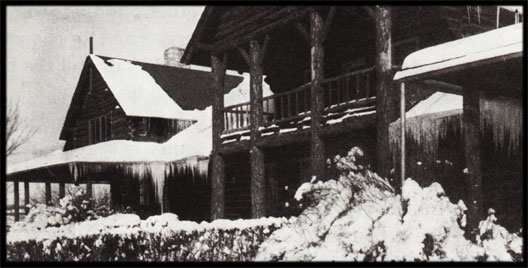 |
||
 |
||

 |
• HOME • GENERAL STORE • NATURAL HERITAGE • HISTORY, CULTURE & CRAFTSMANSHIP |
||||
|
History, Culture & Craftsmanship
• Book Learning |
|||||
| Book Learning Index • Soundly Unlawful • Ozarks Mountaineer • College of the Ozarks School Days Past • Flanders Fields • Declaration Ozark Schools • Bruner School • Wooley Creek Cultural Index • Agriculture • Book Learning • Cooking • Craftsmanship • Faith in the Hills • History • Music • People of the Hills • Storytelling • Tourism |
|||

by Joshua Heston
On a high point overlooking Lake Taneycomo, and within sight of the lights of Branson, the College of the Ozarks remains dedicated to the promise of a good education gained through hard work.
Through the zeal of a young Presbyterian missionary, James Forsythe, the College began in 1906, originally atop Mt. Huggins, east of present-day Branson.
It was not pity, but admiration, that seems to have prompted Forsythe to undertake the mission:
“Mrs. Forsythe wrote that [James Forsythe] ‘admired the mountain people. Many were uneducated and underprivileged, but to him they were people and people for whom Christ died. He wanted better things for them — salvation, education, material blessings’”
It was not an easy process. The first school, located in Forsyth, was a small affair, centered around a single, main structure, named Mitchell Hall.
That hall was destroyed by fire on January, 12, 1915.
The school, now led by William R. Dobyns, moved forward, securing a new location that had, as noted by alumnus and staff member, Elizabeth Andrews, “160 acres and an orchard.”
From the start, the School of the Ozarks, as it was then known, functioned as a work school with a strong Christian ethic.
Students would work on campus rather than pay tuition, a practice that caught on well in the independent-minded region.
The concept, though successful, was not easy and the school suffered multiple setbacks.
In 1930, a fire destroyed the venerable Dobyns Hall (an all-wood structure originally created to represent the state of Maine in the 1906 St. Louis World’s Fair).
Dobyns Hall had served as the primary campus building, just as Mitchell Hall had 15 years earlier.
The Depression soon forced staff and student alike to find ways to finance the school and save money.
Results ran from the difficult (such as significant salary cuts for all faculty) to the creative (a student project to bake fruitcakes for donors).
The fruit cake tradition continues to this day, with over 25,000 cakes baked and shipped from the campus every year.
World War II, following the heels of the Great Depression, would also greatly affect the College. This is, perhaps, best remembered by a poignant writing from a school publication in 1941:
As this little paper goes to press, the United States has been attacked by Japan. The war comes very close to our door, because we have boys in the Philippines, in Hawaii, Guam, Midway, and all over the Pacific. Probably 75 of our boys are in the Pacific. Concern for them and concern for our country makes all of us here at The School feel that we should work all the harder....
Many of those young students would not return from war, a fact which seems to have only galvanized the institution's patriotism and work ethic.
(continued above right)
| Credits — Above, the original Dobyns Hall, which began as the State of Maine building at the 1906 St. Louis World's Fair. The campus' present-day Keeter Center reflects a similar design. Photo courtesy of College of the Ozarks. Many thanks to the faculty and staff of the College of the Ozarks for their support, most notably Elizabeth Andrews of public relations and Annette Sain of the Ralph Foster Museum. State of the Ozarks salutes this unique school for exemplifying modern-day Ozark heritage. Suggested reading — Miracle of the Ozarks by Jerry C. Davis. ______ To learn more, be sure to check out these StateoftheOzarks articles related to the College of the Ozarks: • Edwards Mill, A Tradition • Makin' Fruitcake • The Ralph Foster Museum |
|||
The ’50s were a time of optimism for the College and under the leadership of two deans, Robert M. Good and M. Graham Clark, the school gathered momentum:
A hospital was built, contruction started for an ambitious gothic chapel (with all building done by students), and, in 1958, the first college-level classes were offered.
Campus property had now increased to 1,400 acres and included 50 buildings.
Through the tumultous decades of the '60s and ’70s, the College of the Ozarks continued a simple mission:
Hard work and a good education.
Today, faculty and students alike are genuinely proud of their accomplishments.
The College maintains its own beef and dairy farms. The fruitcake and jelly kitchen continues to churn out products sold as far away as Europe and Japan.
The Edwards Mill, built in the early 1970s, is a working grist mill dedicated to “preserving the heritage of the Ozarks.”
The Ralph Foster Museum, begun in a boys’ dormitory back in the ’20s, has developed into a massive, three-floor complex with 20,000 square feet of exhibits.
And every year, convocation speakers are brought in — speakers with names like General Colin Powell, the late Gerald Ford (who loved the fruitcake and sent a hand-written letter to prove it), and former prime minister Margaret Thatcher.
Today, well into the 21st century, the College of the Ozarks continues its mission, stated so succinctly by Dr. Clark, back in the ’40s:
“[A] mountain school educating young people who were found worthy but without sufficient means to pay for an education...to give them the benefits of a Christian education.”
______
©StateoftheOzarks.net2008
April 10, 2008